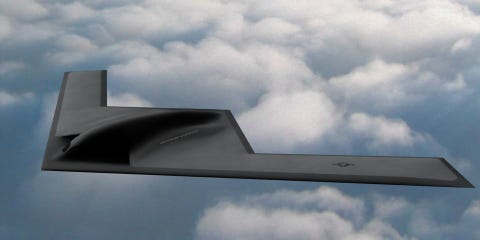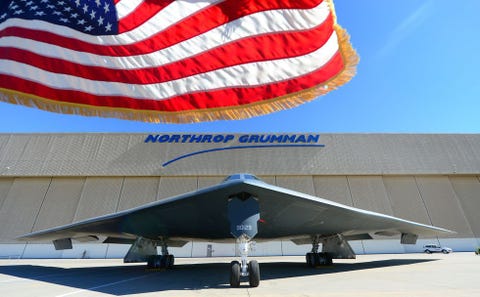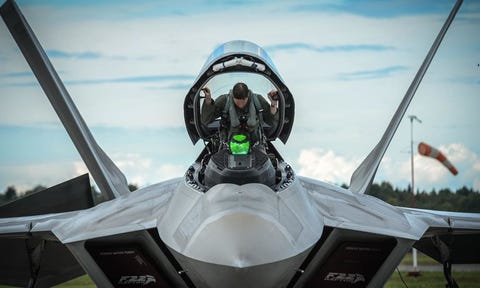New U.S. Secret Bomber Program Passes Critical Design Review
But it still has a long way to go.
By Joe Pappalardo NORTHROP GRUMMAN
NORTHROP GRUMMANThe Air Force’s secret stealth bomber program has passed a major early milestone, according to Air Force officials. "Our most recent review was last week, and the B-21 Raider is on schedule and performance," Air Force Secretary Heather Wilson said at a defense forum in California over the weekend.
Air Force officials confirmed to Popular Mechanics that she was referring to the Critical Design Review (CDR), considered a major milestone in the program. Here's what that means—and what it means for the future of the next great bomber.
Avoiding Warplane Hell

Northrop Grumman's B-2 Spirit.
GETTY IMAGES
The central question of the Pentagon's CDR process is determining whether a program is mature enough to dive into the deep end of full-scale fabrication and testing. There are details about factory hardware, production processes, and software specifications to look at. The review also matches the program requirements with a budget and a schedule. One can infer from this news that the CDR confirmed the Air Force’s stated $550 million per Raider price tag.
The B-21 will carry conventional and nuclear weapons on penetration missions that can duck advanced air defenses. It will be capable of operation by an onboard crew or piloted remotely. The Raider is projected to enter service in the 2020s with an initial fleet of 100 aircraft.
The B-21 is a major program, but the Pentagon is handling it differently than others, hoping to avoid the development hell that plagues other warplanes. The B-21 program is managed through the Air Force Rapid Capabilities Office, which has a much leaner office and less overhead than any other major program.
A Congressional Research Service report issued in October said the defense appropriate bill allocated $2.31 billion in the fiscal year 2019 budget for B-21 development. Representatives from Northrop Grumman declined to answer any questions about the bomber program.
Not a Raptor Repeat

USAF
So what does passing the CDR mean for the Raider? Well, it's certainly good news. A delay at this point could indicate struggles within the Pentagon to finalize requirements. But there are plenty of harder milestones ahead, ones that proved to be stumbling blocks for other warplanes such as the F-22 Raptor.
The Air Force began the F-22 development program in 1991, finished the preliminary design review in April 1993, and completed its critical design review in February 1995.
But in 1996 brought real trouble. A Joint Estimate Team concluded that the F-22 development program would require additional time and a $1.45 billion increase in cost, warning of a larger increase of $13 billion if other risks were not averted. So a clean bill of health in a CDR does not ensure long-term success.
But there is reason to hope the B-21 program will fare better. After all, the F-22 took about 20 years to reach initial operations, while the Raider is slated to do the same in just ten.
The CDR report noted that the B-21’s “proposed funding and deployment schedule implied that considerable development had been accomplished prior to contract award. The Air Force later confirmed this, with senior program officials stating that both competing designs were at an unusually high level of detail and development for a system in which the prime contractor had not been selected.”
A New Home in Oklahoma

Secretary of the Air Force Heather Wilson receives an overview of the KC-46A program and its maintenance campus under construction at Tinker Air Force Base in Oklahoma.
KELLY WHITE / USAF
It’s not just Wilson’s comments about the classified program that indicate progress. In late November, the Air Force announced that Tinker Air Force Base, Oklahoma, will coordinate maintenance and sustainment of the B-21 Raider. Edwards AFB, California, will lead testing and evaluation.
There are more than a thousand Northrop employees working on the project at a top-secret restricted site outside Palmdale, California. An L.A. Times report shows that money is being poured into the project with employees working in “rows of temporary trailers, a dozen tan-colored tents, and a vast assembly hangar… Construction crews are getting ready to add 1 million square feet to the plant, a 50 percent increase over what is already a huge facility that is protected by razor wire-topped fences, electronic sensors and military air space surveillance…”
Although there are many milestones to go, with the CDR done and the production adhering to that ten-year plan, the Raider has a shot at being the rarest of defense aviation programs—one that comes in on time and on budget.
No comments:
Post a Comment